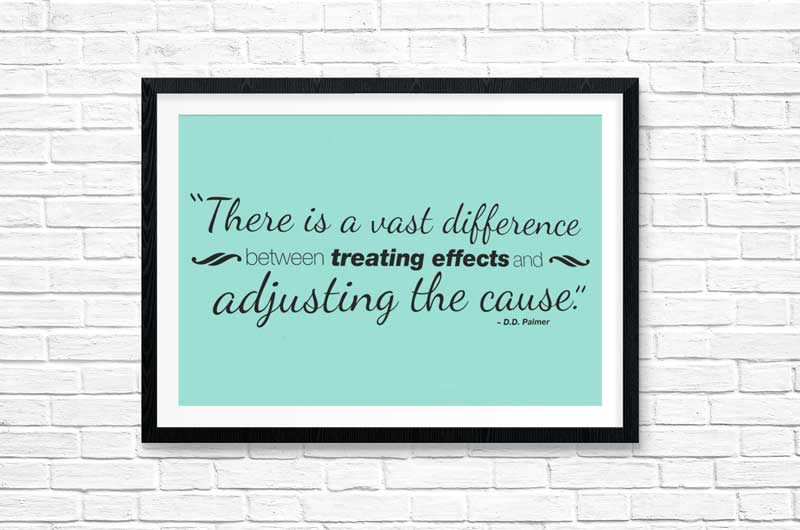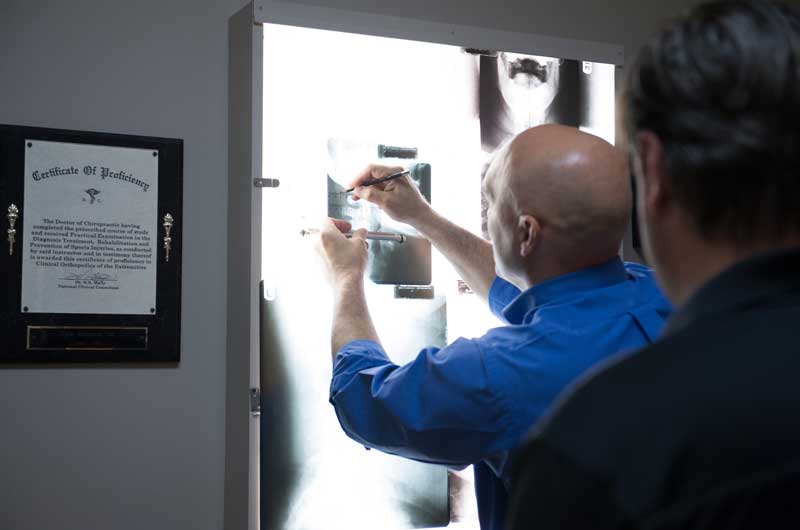One of the biggest hurdles people face when considering chiropractic care is the thought that once you start going, you can’t ever stop. That somehow getting adjusted makes you more dependent on needing to get adjusted over and over. If you or a friend has ever had that concern, please keep reading!
We have all grown up in a health care model that focuses on symptoms as the problem. If we have a headache, we take a pain reliever. If we have a fever, we reduce it. If we have a sinus infection, we get an antibiotic. Muscle spasm? Muscle relaxant. Swelling? Anti-inflammatory. You get the idea.
So, when we encounter a health care model that often doesn’t immediately alleviate our pain and seems to take a little more time, it can feel like it runs counter to our assumptions about health care. Chiropractic care definitely fits into that group of therapies.
Why is that? Because chiropractors are very interested in why you are having your headache, fever, sinus infection, muscle spasm, or swelling. It is not enough to identify a symptom and eliminate it, because without addressing the underlying cause of that symptom, it is very likely to return – often worse than before.
Want to ask Dr. Rich a question? You can do that here.
Structure Dictates Function
As an engineer, I am very interested in how structure dictates function. In simple terms, this means that you can pretty much tell that you use a spoon for your soup and a knife to cut your steak and not vice versa. In the human body, we have an incredible structure called the spine that protects our delicate nervous system – the system that literally runs your body and determines your health status on a moment by moment basis.
The structure of this engineering marvel dictates function too. In its normal state, the spine is designed to protect the spinal cord and nerves without getting in the way of the function of the nerves (carrying vital health messages to all parts of your body). Unfortunately, the daily stresses and strains we put on our bodies can cause the spine and surrounding muscles to get out of balance, which most definitely changes the way the nerves in our body transmit their messages.
Our daily stresses and strains show up in our posture and how we move. When you hold yourself and move in an unbalanced way over a period of time, many important things happen:
- Muscles adapt
- Ligaments change
- Nerves are under sustained altered tension
- Bones eventually start to change shape
- Your body compensates to preserve balance
All of this imbalance can be repaired. The notion that we are somehow stuck in certain patterns of posture or movement doesn’t make sense logically. I have heard people say that their posture is just how they are shaped, that the imbalance in their movement is somehow permanent. If that were true, then working out, training for a sport, yoga, ergonomics, and a host of other things we do for our health wouldn’t make any sense at all.

Designed for Change
Our bodies are actually designed for change. In another feat of engineering brilliance, God designed your body to be adaptable. Bones can actually change shape depending on the stress you put on them. Muscles can strengthen, lengthen, and shorten based on how we use them. Ligaments can change their shape if stretched slowly over time (that’s how braces work).
Our brain controls joint use patterns down to the tiniest joints between spinal bones. These use patterns can be changed as well. Think of the very first time you drove a car. You had to think of every move. Now everything happens automatically. Your body seems to know how to make subtle adjustments to the pressure of your foot on the gas pedal and exactly how much to turn the wheel for a smooth turn.
Ready to schedule a visit? You can do that here.
Getting to the Root of the Problem
Much of the imbalance I see in people’s spine is a slow process that happens over a long time, usually with some traumatic injuries (slips and falls, sports injuries, car accidents, etc.) mixed in for good measure that were never properly repaired.
Since the body is amazing at compensating for problems, most patients have found movement patterns and postures (and often medications) that have helped them stay relatively symptom-free, or at least functional in their day. Finally, they have run out of ways to get their spine out of the way of their nerves, and pain shows up that just keep coming back worse and more frequently. They go find that crazy friend or co-worker and quietly ask them “Who is that chiropractor you go to?”
By the time they make it to my office, there are often years of imbalance that need to be addressed and repaired. Contrast that with the symptom-relief model most of us grew up in, and you can readily see the disconnect many people have with chiropractic care. “But doc, I just came in for my low back pain!” instead of “Doc, I understand I’ve been building this problem over years – how do we fix this?”
An examination of a typical first-time patient usually reveals all of the things I talked about earlier – muscle changes, joint changes, ligament changes, and even bone re-shaping based on stresses applied over a long time.

Health is a Process, Not an Event
Anyone doing chiropractic care aimed at getting to the root cause of health issues has to honor the fact that changing the locomotor system takes two very important things – time and frequency.
Restoration of health is a process, not an event. In a very real sense, what chiropractors do is coach you through the process of re-training your posture and your movement patterns to restore the normal position and motion of your frame. We do this so that the spine can get out of the way of how the nerves are supposed to be controlling your body on a moment by moment basis.
Let’s go back to our driving analogy. How often did you have to practice when you were first getting your license before things started to smooth out? How many weeks or months did this take? It’s very likely that you didn’t just drive a couple of times every now and then to become an expert at driving. Likewise, re-training motion and posture takes time and frequency.
So…Do I Have to Go Forever?
OK, now that we have some background, let’s answer that question.
No.
How long someone benefits from re-training their posture and movement patterns is always up to them. In the beginning, training is frequent because old patterns, muscle memory, and poorly repaired injuries must be overcome. The initial phases of repair are often done at 2-3 office visits per week.
Eventually, enough change takes place that the majority of patients have symptom relief and better posture and movement. If a normal posture and normal movement patterns can be completely restored, the rehabilitation process is finished.
At this point, most people choose to enter a preventive wellness or maintenance phase of care. Understanding that their movement patterns and injury history are what got their frame out of balance in the first place, they choose to get checked for any small imbalances before their posture or motion patterns become distorted enough to affect nerve function in a negative, ongoing way.
Ready to schedule a visit? You can do that here.
You Still Haven’t Answered the Original Question! I’m Worried I’ll Get Addicted to Adjustments!
- “Don’t adjustments make the spine ‘too loose’?”
- “Doesn’t repetitive ‘cracking’ of my joints make them unstable and lead to arthritis?”
- “I always heard that cracking your knuckles was bad…why is cracking your spine good?”
The list of these types of questions is long, but they are important questions. The answer to all of these questions lies in an understanding of exactly what happens during an adjustment.
It’s important to understand that there is no randomness to an adjustment. There is always analysis, assessment, correlation, planning, and execution involved.
In other words, as an engineer, it is my responsibility to restore normal mechanics to the joints of your body. If that is my responsibility, then I need a method to analyze and assess what is normal and what is abnormal. Once I find abnormal posture or movement (at a joint level or in global motion patterns), I must have a method of correlating that abnormal movement to the muscles attached to the area and the nerves affected by the dysfunction. Then I must develop a plan to correct the abnormal motion in the most efficient and least invasive way. Then I must execute my plan properly and re-assess to ensure I’ve done my job. This process happens on every office visit with every patient.
Adjustments are only ever done to improperly moving joints. Joints that don’t have their full range of normal motion. Adjustments are never done to properly moving joints that already have their full, balanced, normal range of motion.
Adjustments restore normal from abnormal. This is how adjustments differ from randomly “cracking” knuckles.
When someone cracks their knuckles, they are taking normal joints and pushing them past their normal limits of motion to get them to cavitate, or “crack.” This movement past normal end range causes the capsule (the retaining ligaments around the joint) to stretch over time. A stretched out capsule causes sloppy joint movement over time, a condition known as hypermobility. Hypermobile joints wear out faster, causing early arthritis and weak, painful movement in those joints.
So, the real answer to the original question is that adjustments restore normal motion and position to spinal joints, allowing both the spine and the nerves it protects to function in a healthy, balanced way. The joints don’t get looser. In fact, they become better at doing the job they were designed to do. The people you know who regularly visit their chiropractor aren’t crazy. They’re just used to a healthier, more balanced function in their body.
Ready to schedule a visit? You can do that here.
